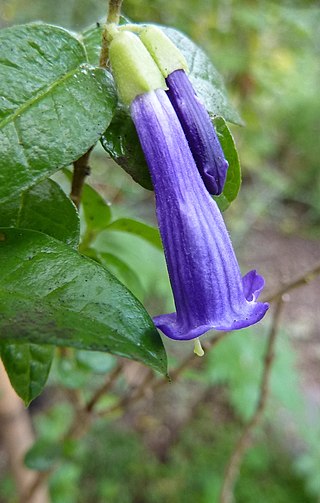
Puya raimondii, also known as queen of the Andes (English), titanka and ilakuash (Quechua) or puya de Raimondi (Spanish), is the largest species of bromeliad, its inflorescences reaching up to 15 m (50 ft) in height. It is native to the high Andes of Bolivia and Peru. It was once hypothesized to be a protocarnivorous plant.

An IUCN Red List Critically Endangered species is one that has been categorized by the International Union for Conservation of Nature as facing an extremely high risk of extinction in the wild. As of 2021, of the 120,372 species currently tracked by the IUCN, there are 8,404 species that are considered to be Critically Endangered.

Juania australis, the Chonta palm, is a species of flowering plant in the family Arecaceae, the only species in the genus Juania. It is a solitary trunked palm tree which is endemic to the Juan Fernández Islands archipelago in the southeast Pacific Ocean west of Chile.
Puya aequatorialis is a species of plant in the family Bromeliaceae. It is endemic to Ecuador. Its natural habitats are subtropical or tropical dry forests and subtropical or tropical dry shrubland. It is threatened by habitat loss. There is little information known about this species.
Puya angelensis is a species of plant in the family Bromeliaceae. It is endemic to Ecuador, where it is known from three locations in Carchi Province.
Puya compacta is a species of puya in the family Bromeliaceae. It is endemic to Ecuador.
Puya exigua is a species of plant in the family Bromeliaceae. It is endemic to Ecuador. Its natural habitat is subtropical or tropical high-altitude grassland. It is threatened by habitat loss.
Puya glomerifera is a species of plant in the family Bromeliaceae. It is endemic to Ecuador. Its natural habitats are subtropical or tropical dry shrubland and subtropical or tropical high-altitude shrubland. It is threatened by habitat loss.
Puya maculata is a species of plant in the family Bromeliaceae. It is endemic to Ecuador. Its natural habitat is subtropical or tropical high-altitude grassland. It is threatened by habitat loss.
Puya nutans is a species of plant in the family Bromeliaceae. It is endemic to Ecuador. Its natural habitat is subtropical or tropical high-altitude grassland. It is threatened by habitat loss.
Puya obconica is a species of plant in the family Bromeliaceae. It is endemic to Ecuador. Its natural habitats are subtropical or tropical moist montane forests and subtropical or tropical high-altitude shrubland. It is threatened by habitat loss.
Puya parviflora is a species of plant in the family Bromeliaceae. It is endemic to Ecuador. Its natural habitats are subtropical or tropical moist montane forests and subtropical or tropical high-altitude shrubland. It is threatened by habitat loss.
Puya pichinchae is a species of plant in the family Bromeliaceae. It is endemic to Ecuador. Its natural habitat is subtropical or tropical dry shrubland. It is threatened by habitat loss.
Puya pygmaea is a species of plant in the family Bromeliaceae. It is endemic to Ecuador. Its natural habitat is subtropical or tropical high-altitude grassland. It is threatened by habitat loss.
Puya retrorsa is a species of plant in the family Bromeliaceae that is endemic to Ecuador. Its natural habitats are subtropical or tropical dry shrubland and subtropical or tropical high-altitude shrubland. It is threatened by habitat loss.
Puya roseana is a species of plant in the family Bromeliaceae. It is endemic to Ecuador. Its natural habitat is subtropical or tropical moist montane forests. It is threatened by habitat loss.
Puya sodiroana is a species of plant in the family Bromeliaceae. It is endemic to Ecuador. Its natural habitat is subtropical or tropical moist montane forests. It is threatened by habitat loss.

Rhaphithamnus venustus, known locally as Juan Bueno, is a species of plant in the family Verbenaceae. It is endemic to the Juan Fernández Islands, an archipelago west of Chile. It is threatened by habitat loss.
Rudgea crassifolia is a species of plant in the family Rubiaceae. It is endemic to Brazil. Its natural habitat is subtropical or tropical dry shrubland. It is threatened by habitat loss.

Puya dyckioides is a species of flowering plant in the Bromeliaceae family. It is native to Bolivia.






